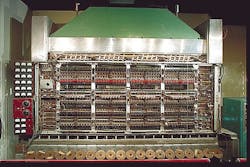Béla Lipták Looks Back at a Half-Century of Process Automation
My Past
In 1956, we Hungarians fought for freedom and independence, and tried to get rid of Soviet occupation. We used the Molotov cocktail and small arms against their 2,400 tanks. Obviously, we were crushed, and 250,000 young and educated Hungarians (2.5% of the population) escaped. I was one of them.
Later, I received a scholarship at the Stevens Institute of Technology and graduated there. At this point I got lucky, because a former commissioner of President Roosevelt, Sam Russell, had just started an engineering firm and he hired me. During World War II, Sam's job was to replace the natural rubber supplies that were blocked by the Japanese, with synthetic rubber. He did—he knew how to get things done.
His engineering design firm, Crawford and Russell, which focused on plastics, was a success, and I, as his chief instrument engineer, had to hire more and more people, because jobs were coming in left and right. I remember it was an ABS plant for GE in 1959 where I first used a computer. It was little different from John von Neumann's IAS (Figure 1). At that time, vacuum tubes had just been replaced by silicon transistors, and nobody had yet heard of MOS semiconductors or microprocessors.
Figure 1: John von Neumann's IAS computer.
Source: Wikipedia
So I had to hire people. With my thick Hungarian accent and 25 years of age, I did not feel comfortable hiring experienced engineers, so I asked Sam to let me hire smart, fresh graduates from the best schools, and to let me use every Friday to teach them our profession. He agreed, and in a couple of years I had the best instrument engineering department of 26 "kids." I also had a foot-high pile of my "Friday notes" accumulated on the corner of my desk. At this point I got lucky again, because an old fashioned publisher named Nick Gronevelt visited me. He reminded me of my grandfather, as his hair was parted in the middle and his watch was held by a gold chain hanging from his vest-pocket.
Nick asked why I didn't teach from an instrument handbook and I told him, "Because we have none."
See Also: Process Automation Generations Talk to Each Other
"So let us turn your Friday Notes into one," he said, and in 1963 the first edition of my The Instrument Engineers Handbook (IEH) was published. The co-authors included such names as Page Buckley, Hans Baumann, Greg Shinskey, Paul Murrill, Les Driscoll and Cecil Smith, and the preface was written by Edward Teller, who understood the future of automation. I dedicated the book to the Hungarian Freedom Fighters.
Today, 50-plus years later, I am working on the fifth edition.
Where Are We Today?
In the 1950s, our profession was called instrumentation; now it is called automation. Today we have robots on Mars that can vaporize the rocks by laser to determine their composition, and soon, while sitting in our hydrogen-fueled driverless cars, we will be able to order pizza to be delivered hot by the time we get home, and our smart car is parking itself.
At the time of the first edition, I was teaching process control in the chemical engineering department of Yale University, and my handbook was published by the electrical engineering division of Chilton. Why? It was not because Yale or Chilton had something against our profession. No, it was because they did not even know that the profession of process control existed. So how much change occurred over the past 50 years? Not that much.
Well, to my knowledge, one still cannot receive a Ph.D. in automation, and only a few universities offer a bachelor of science or even associate degrees in automation and control engineering . There are a number of certification programs, and ISA currently offers two : Certified Automation Professional (CAP) and Certified Control Systems Technician (CCST). Online certificates also are offered at the University of Kansas and at Dalhouse University.
Man vs. Machine
While much has been done to advance automation, even more remains to be achieved. We live at a time when cultural attitudes are changing as we debate the proper role of machines in our lives. Our culture now accepts that there is no harm in machines substituting for the routine functions of the human brain.
While in everyday life we accept the spread of automation, in most of our industries, the operator is still the boss. Automation is seldom used to protect against operator errors.
Safety statistics show that the number-one cause of industrial accidents is human error. One could refer to Three-Mile Island, where the operators injected water into the instrument air supply, to the BP accident, where there was no automation to keep the drilling pipe straight, to the ferry accident in Korea where safety overrides were not provided to prevent the captain from turning sharply into a fast ocean current, or to airplane accidents where the pilots were not prevented from landing at the wrong speeds or gaining altitude too fast. The list goes on.
In other words, the culture of trusting man more than machine has to change. It has to be recognized that safety provided by automation is also manmade, but it is made by different men than the panicked rooky operators running around in the dark at 2 a.m., as occurred at Chernobyl. No, safety automation should be designed by professional control engineers, who have spent months to identify all potential "what if" sources of possible accidents, and have evaluated their potential consequences before deciding on the emergency actions that are to be triggered automatically when the potentials for such accidents arise.
It is this hazard and operability study (HAZOP) during the design phase of the plant that is the key to safety, not dependence on the action of panicked operators. The choice is not between depending on humans or machines. The choice is between trusting the judgment of two kinds of people: the operator or the HAZOP team.
For absolute safety, what is needed is override safety control (OSC), which cannot be turned off or overruled by anything or anybody. When the plant conditions enter a highly accident-prone, life-safety region, the uninterruptible safe shutdown of the plant must be automatically triggered. The functioning of OSC must be so designed that it cannot be stopped by cyber attacks, because it is not connected to the Internet at all. It can not be overruled by the operators and cannot be modified or turned off by them. In short, once the OCS is activated, the plant must be shutting down under the preplanned, totally automatic HAZOP control, and nothing and nobody can prevent that.
The Status Quo
During the past 50 years, some progress has been made, but not enough. Ours is the profession that can simultaneously maximize production and safety while minimizing operating and energy costs. Optimization through automation can simultaneously increase GDP and profitability, and can do it while also reducing both pollution and energy consumption. We can increase productivity without using a single pound of additional raw material and without spending a single additional BTU of energy, plus we can also protect our industries from human errors, sabotage or cyber terrorism.
I hope that in the next 50 years this will finally be understood.
[javascriptSnippet]







